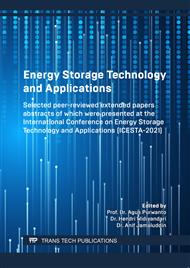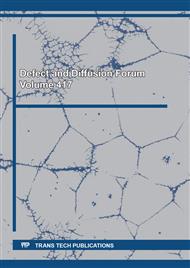[1]
X. Liu, K. Li, X. Li, The Electrochemical Performance and Applications of Several Popular Lithium-ion Batteries for Electric Vehicles - A Review, Springer Singapore, 2018. https://doi.org/10.1007/978-981-13-2381-2.
Google Scholar
[2]
G. Zubi, R. Dufo-lópez, M. Carvalho, G. Pasaoglu, The lithium-ion battery : State of the art and future perspectives, 89 (2018) 292–308. https://doi.org/10.1016/j.rser.2018.03.002.
DOI: 10.1016/j.rser.2018.03.002
Google Scholar
[3]
F. Wu, X. Li, Z. Wang, H. Guo, Synthesis of chromium-doped lithium titanate microspheres as high-performance anode material for lithium ion batteries, Ceram. Int. 40 (2014) 13195–13204. https://doi.org/10.1016/j.ceramint.2014.05.025.
DOI: 10.1016/j.ceramint.2014.05.025
Google Scholar
[4]
S. Hymel, What is a Battery?, (n.d.). https://learn.sparkfun.com/tutorials/what-is-a-battery/all.
Google Scholar
[5]
D. Deng, Li-ion batteries: Basics, progress, and challenges, Energy Sci. Eng. 3 (2015) 385–418. https://doi.org/10.1002/ese3.95.
DOI: 10.1002/ese3.95
Google Scholar
[6]
I.D. Johnson, M. Lübke, O.Y. Wu, N.M. Makwana, G.J. Smales, H.U. Islam, R.Y. Dedigama, R.I. Gruar, C.J. Tighe, D.O. Scanlon, F. Corà, D.J.L. Brett, P.R. Shearing, J.A. Darr, Pilot-scale continuous synthesis of a vanadium-doped LiFePO4/C nanocomposite high-rate cathodes for lithium-ion batteries, J. Power Sources. 302 (2016) 410–418. https://doi.org/10.1016/j.jpowsour.2015.10.068.
DOI: 10.1016/j.jpowsour.2015.10.068
Google Scholar
[7]
Q.Q. Xiong, J.J. Lou, X.J. Teng, X.X. Lu, S.Y. Liu, H.Z. Chi, Z.G. Ji, Controllable synthesis of N-C@LiFePO4 nanospheres as advanced cathode of lithium ion batteries, J. Alloys Compd. 743 (2018) 377–382. https://doi.org/10.1016/j.jallcom.2018.01.350.
DOI: 10.1016/j.jallcom.2018.01.350
Google Scholar
[8]
I.D. Johnson, E. Blagovidova, P.A. Dingwall, D.J.L. Brett, P.R. Shearing, J.A. Darr, High power Nb-doped LiFePO4 Li-ion battery cathodes; pilot-scale synthesis and electrochemical properties, J. Power Sources. 326 (2016) 476–481. https://doi.org/10.1016/j.jpowsour.2016.06.128.
DOI: 10.1016/j.jpowsour.2016.06.128
Google Scholar
[9]
X. Dong, T.J. Jeong, E. Kline, L. Banks, E. Grulke, T. Harris, I.C. Escobar, Eco-friendly solvents and their mixture for the fabrication of polysulfone ultrafiltration membranes: An investigation of doctor blade and slot die casting methods, J. Memb. Sci. 614 (2020) 118510. https://doi.org/10.1016/j.memsci.2020.118510.
DOI: 10.1016/j.memsci.2020.118510
Google Scholar
[10]
M. Wang, X. Dong, I.C. Escobar, Y.T. Cheng, Lithium Ion Battery Electrodes Made Using Dimethyl Sulfoxide (DMSO) - A Green Solvent, ACS Sustain. Chem. Eng. 8 (2020) 11046–11051. https://doi.org/10.1021/acssuschemeng.0c02884.
DOI: 10.1021/acssuschemeng.0c02884
Google Scholar
[11]
J.C. Daigle, F. Barray, C. Gagnon, D. Clément, P. Hovington, H. Demers, A. Guerfi, K. Zaghib, Amphiphilic latex as a water-based binder for LiFePO4 cathode, J. Power Sources. 415 (2019) 172–178. https://doi.org/10.1016/j.jpowsour.2019.01.054.
DOI: 10.1016/j.jpowsour.2019.01.054
Google Scholar
[12]
F.Y. Tsai, J.H. Jhang, H.W. Hsieh, C.C. Li, Dispersion, agglomeration, and gelation of LiFePO4 in water-based slurry, J. Power Sources. 310 (2016) 47–53. https://doi.org/10.1016/j.jpowsour.2016.02.003.
DOI: 10.1016/j.jpowsour.2016.02.003
Google Scholar
[13]
N. Aguiló-Aguayo, D. Hubmann, F.U. Khan, S. Arzbacher, T. Bechtold, Water-based slurries for high-energy LiFePO4 batteries using embroidered current collectors, Sci. Rep. 10 (2020) 1–9. https://doi.org/10.1038/s41598-020-62553-3.
DOI: 10.1038/s41598-020-62553-3
Google Scholar



